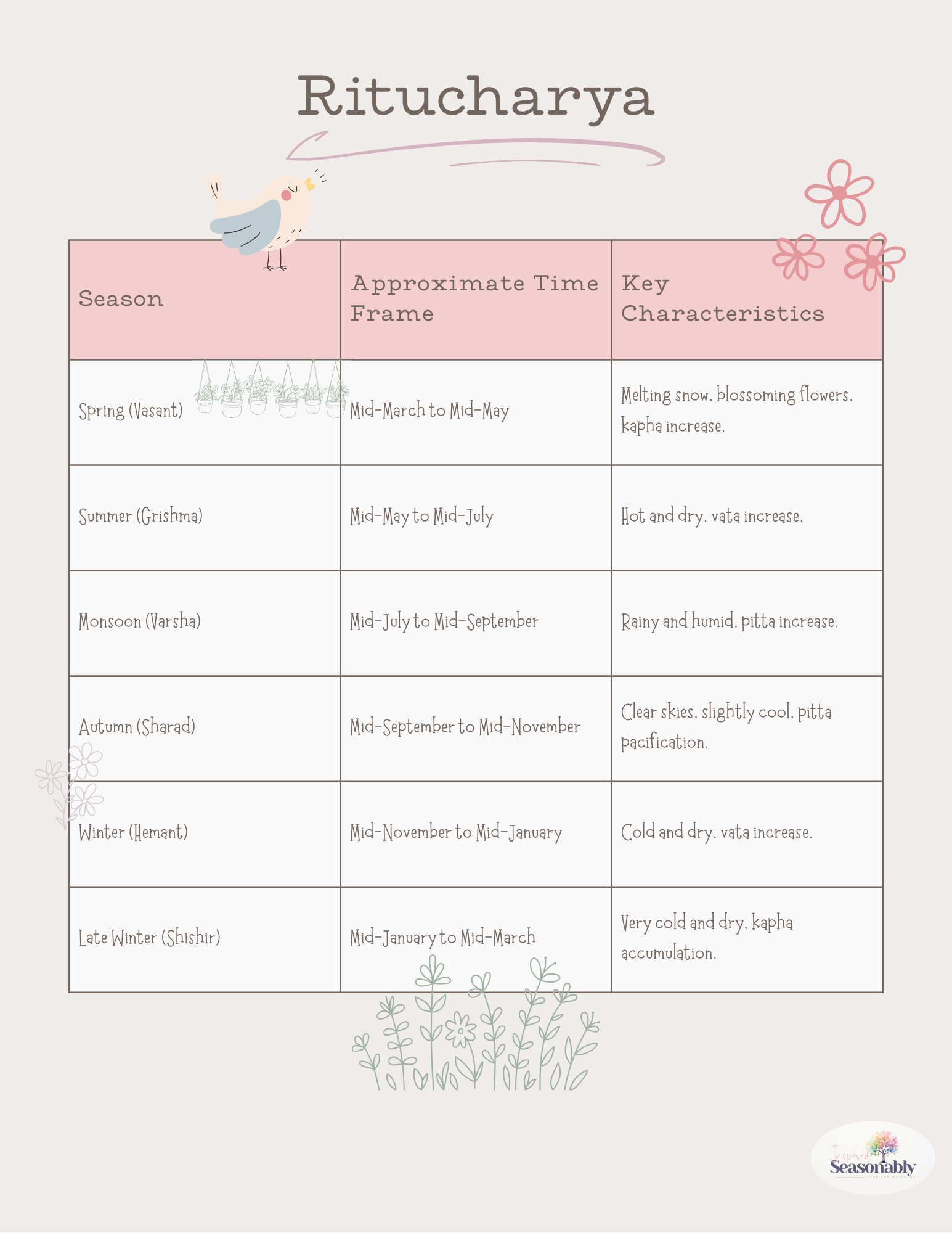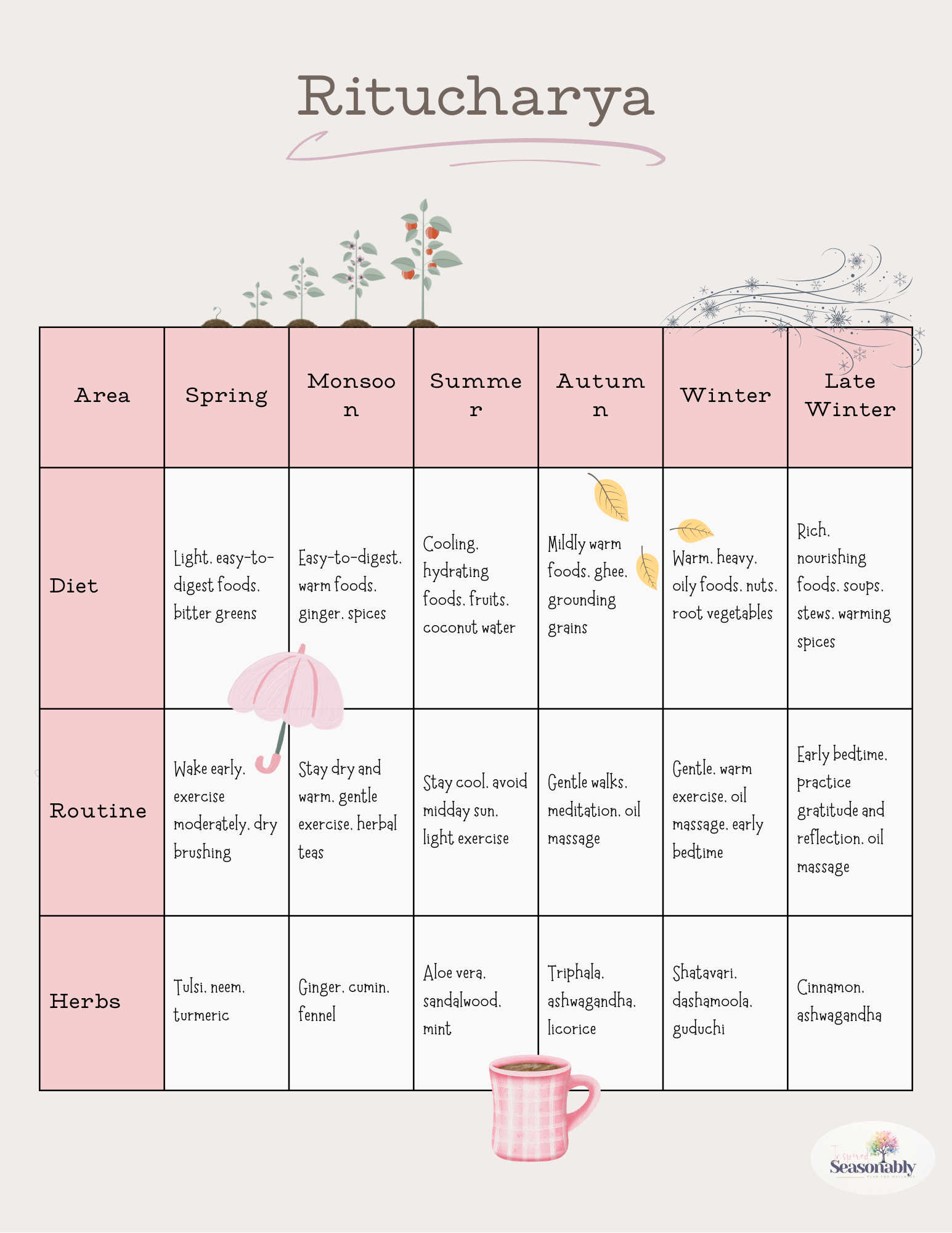Routines for Women’s Wellness
How often do you feel like you are racing through life with very little control over what is actually happening? You are not alone friend, we live in a fast moving world and without a routine to anchor you you’ll just keep racing along trying to keep up. Enter Ritucharya, the Ayurvedic practice of aligning your daily routine with the changing seasons. It may sound complicated, but trust me once you understand how it works it actually saves you time, improves your health, and helps you balance your hormones so you can finally lose weight (or any other health goal you’re struggling with)!
Sound intriguing? Let’s learn some more…
What the heck is Ritucharya?
Ritucharya is the Ayurvedic practice of living in harmony with the seasonal changes by adjusting diet, lifestyle, and daily routine according to the characteristics of each season. The word “ritucharya” comes from two Sanskrit words: “ritu” which means season, and “charya” meaning regimen. (I love Sanskrit- so concise!)
The reason that it’s important to align our self-care routines with the seasons all boils down to dosha balance, and dosha balance is the key to promoting health, wellness, and prevention of illness. When dosha’s are aligned, which is a continuous process, you get enhanced immunity (ojas), internal balance (homeostasis), and prevention of seasonal diseases and imbalance.
So how does it work? It’s actually pretty simple. Each season has a defining set of characteristics- like spring is wet, winter is cold, summer is hot, and so on. Once you know what the seasonal qualities are you can implement daily habits to keep those qualities from accumulating- like not eating ice cream every day in January if you live in a cold climate. If you do choose to eat ice cream, you risk imbalance of the cold, heavy, wet qualities that manifest as mucus, sluggishness, weight gain, and so on.
In essence, ritucharya is being mindful of the environment and using that information to guide your choices about food, lifestyle, even activity.
Wait, how many seasons are there?
If you thought there were only four seasons you haven’t been paying attention. Depending on where you live you might have one or two, you might have four or six. Our modern calendar system neatly organizes seasons into twelve week packets that fit nicely on a calendar grid. It’s predictable, it’s repeatable, it’s marketable. The reality is that seasons have nothing to do with a calendar grid and everything to do with the qualities of the season!
Take spring for example, it may feel like the early days of spring where it’s cold and damp and windy (from an upstate NY perspective) are nothing like the late spring where it’s so hot you’re wondering if it’s too early to turn on the air conditioning. That’s because spring is actually a transition season and has split personality disorder- sometimes identifying as late winter (Shishira) and sometimes as early summer (Vasanta). Most seasons will vary from beginning to end, and if we aren’t adjusting our routines our doshas will also fall out of balance. More on dosha’s coming up.
But first a pretty chart…

Ritucharya’s impact on doshic balance is central to maintaining health in Ayurveda. According to this science, the three doshas — Vata, Pitta, and Kapha — are biological energies that govern all physiological and psychological functions in the body. These doshas naturally fluctuate with seasonal changes, and Ritucharya helps regulate these fluctuations by prescribing season-appropriate diets and lifestyles.
Every one of us has a unique dosha constitution (or make up) that we are born with, how we move through our life determines the types of imbalance that is unique to us individually. For example, a pitta dosha is characterized by hot, intense, fast, oily qualities. During the summer months when it’s hot and dry pitta can become aggravated, this dosha benefits from cooling and slowing down. I think we all know that person who runs a little “hot” and can get over stimulated from time to time. 🙋♀️
🔄 Examples of Seasonal Doshic Balance Through Ritucharya:
In Summer (Grishma):
- Pitta is high due to heat.
- Recommended: Cooling, hydrating foods (e.g., coconut water, cucumbers), avoiding spicy or sour foods.
- Helps pacify Pitta, prevent heat-related imbalances like acidity, skin eruptions, irritability.
In Monsoon (Varsha):
- Vata is aggravated due to dampness and instability.
- Recommended: Warm, unctuous foods (e.g., soups, ghee), grounding routines.
- Helps balance Vata, prevent bloating, anxiety, joint issues.
In Spring (Vasanta):
- Kapha is aggravated due to heaviness and moisture.
- Recommended: Light, warm, dry foods (e.g., barley, honey), more physical activity.
- Helps reduce Kapha, preventing allergies, congestion, lethargy.
Now that you know what to look for, you can begin to notice how many seasons you experience from year to year.
Keep reading to learn how the concept of ritucharya impacts hormone imbalance, including your struggle to lose weight.
Why it is important to you
So, how does this apply to women’s health? Many of the issues we face, like hormone imbalances, GI problems, PCOS, and perimenopause symptoms, are related to imbalances in our doshas. Ritucharya helps us stay balanced, preventing or reducing these issues. By not following ritucharya or a seasonable routine you risk aggravating your dosha and chasing the imbalance from season to season which eventually leads to illness and disease.
To summarize:
- Hormone Imbalance: By aligning with the seasons, we support our body’s natural rhythms, which helps regulate hormones. Think of it like a reset button for your system.
- GI Conditions: Eating seasonal foods and adjusting our diet per the season supports healthy digestion. This can ease bloating, constipation, and other GI issues.
- PCOS: Ritucharya helps manage stress and weight, both key factors in PCOS. Following a seasonal routine can balance hormones and improve overall health.
- Peri/menopause: As our bodies change during perimenopause, Ritucharya provides a gentle, natural way to support these transitions. By calming vata and pitta, we can reduce hot flashes, mood swings, weight gain and sleep disturbances.
These are just a few examples, but the reality is if there is a chronic or recurring condition it’s likely related to an imbalance of the doshas. Everything from inflammation which is the gateway to serious illness, to seasonal allergies and dietary intolerance stem from how the dosha’s are balanced or not. This can get complicated, so let’s keep it simple. Learning to hear what your body is telling you is the best way to create seasonable routines that will lead to better health, time saved, and goals met.
All this talk about doshas, if you want to learn what your dosha is you can check out the dosha quiz on Banyan Botanicals website- it’s my favorite one out there right now.
A guide to simple ritucharya
To give you an idea of some simple habits you can use to find seasonable balance here’s another pretty chart…

Again, a pretty chart doesn’t mean that it’s a perfect fit for you. When working with clients we always start with the first step: assess. Take a week to simply observe what you notice. Journal your symptoms, habits, and even the weather to begin to create your own ritucharya.
Want more (I know it’s fantastically addicting) head over to Live Seasonably on Substack and subscribe to follow along in real time where I share seasonable eating, living, and protocols for women’s health and wellness.
“Mother Nature has a schedule — ignore it, and she’ll send you a seasonal subscription of sniffles and sluggishness!”
